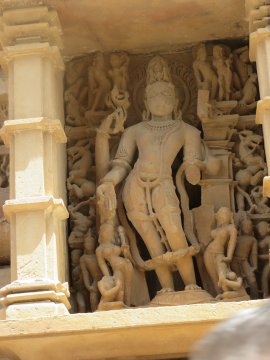Interesting and Fun Facts about Khajuraho Temple
-
The Khajuraho group of monuments has
been listed as a UNESCO World Heritage Site.
-
Khajuraho has the largest group of
medieval Hindu and Jain temples and is well-known for erotic sculptures
adorning the temples.
-
The name Khajuraho is derived from
the Hindi word 'khajur', which means 'date palm'.
-
It was during the reign of Chandel
Empire, between 950 and 1050 AD, that Khajuraho temples were constructed.
-
Earlier, there were about 85 Hindu
temples at Khajuraho, which degenerated due to the ravages of the nature.
There are only about 22 Hindu temples left now.
-
It was only in the 20th century that
Khajuraho temples were rediscovered and preserved.
-
These temples are considered the "high
point" of Indian architectural genius during the medieval times.
-
Khajuraho temples are divided into
three geographical divisions - western, eastern and southern.
-
The Western group is home to the largest
and most typical Khajuraho temple, dedicated to Kandariya Mahadev.
-
The fascinating temples of Khajuraho
represent the expression of a highly matured civilization. They comprise
of one of the top tourist attractions of India.
-
It is wrongly believed that Khajuraho
temples are filled with erotic sculpture. Erotic scenes represent a relatively
small part of the carvings, but sensuous eroticism prevails in all the
sculptures.
-
Archeological Survey of India has ranked
Khajuraho temples as the best preserved monuments of antiquity.
-
A few of the temples in Khajuraho are
dedicated to the Jain pantheon and the rest to Hindu deities - to God's
Trio, Brahma, Vishnu and Shiva and various Devi forms, such as the Devi
Jagadambi.
-
Mostly, the temples are built of sandstone,
with varying shades of buff, pink and pale yellow.
-
The divine sculptures in Khajuraho
temples are a tribute to Life itself, embodying everything that is sublime
and spontaneous about it.
-
The images of Goddesses and Gods sculpted
on the temple walls represent the many manifestations of the divine Shakti
and Shiva, the female and male principles, the Yin and the Yang.
-
The inside of the temple has rooms
that are inter-connected and placed in an East/West line. Each contains
an entrance, a hall, a vestibule and a sanctum. Windows have been added
to the larger temples, probably to add a feeling of space and light.
-
Khajuraho temples, constructed with
spiral superstructures, adhere to a North Indian shikhara temple style
and often to a Panchayatana plan.
|






































